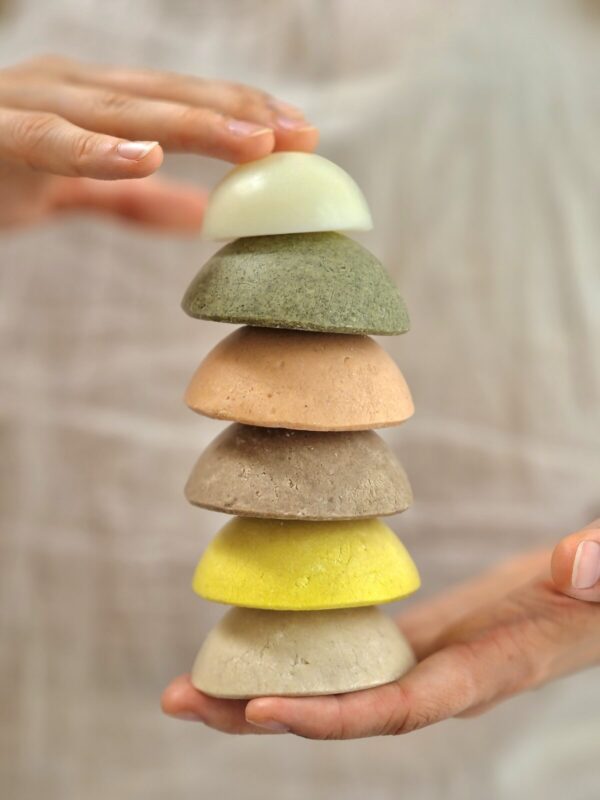Uncategorized
Shampoo Bars vs. Liquid Shampoo: Which is Better for Your Hair?
Estimated reading time: 6 minutes
Table of contents
Shampoo bars vs. liquid shampoo are two popular choices in today’s hair care world, but which is better for your hair? As eco-friendly beauty products gain more traction, many people are considering making the switch from traditional liquid shampoos to solid bars. But before you make any changes to your hair care routine, it’s important to know the differences between the two and what works best for your specific needs. In this guide, we’ll compare shampoo bars and liquid shampoos, break down their pros and cons, and help you decide which is right for you!
What Are Shampoo Bars?
Shampoo bars are concentrated, solid forms of shampoo. They are typically made from natural ingredients and often free of the chemicals found in conventional liquid shampoos. Although shampoo bars have been around for centuries, their popularity has skyrocketed recently due to the growing movement toward sustainability.
- How They Differ from Liquid Shampoo:
- Shampoo bars are compact, long-lasting, and free of the water that liquid shampoos contain. They often come in minimal or zero-waste packaging, making them an environmentally friendly choice.
- Popular Ingredients in Shampoo Bars:
- Many shampoo bars contain nourishing, natural ingredients such as:
- Coconut oil for hydration
- Shea butter for softness
- Essential oils like lavender or tea tree for scalp health
Explore some of our top shampoo bars:
- Solid Shampoo for Oily Hair – Nettle and Lavender
- Solid Shampoo for All Hair Types – Orange Peel and Ylang Ylang
- Solid Shampoo for Hair Growth – Maca and Rosemary

What Is Liquid Shampoo?
Liquid shampoo is the traditional form most people are familiar with. It’s widely available and comes in various formulations tailored to different hair types. Typically sold in plastic bottles, liquid shampoos are easy to use but may not be as environmentally friendly as shampoo bars.
- Why Liquid Shampoo Remains Popular:
- Liquid shampoo is convenient, easy to use, and often tailored to specific hair types (e.g., curly, dry, oily). It’s available everywhere, and many people are used to the lather and texture that liquid shampoo provides.
- Common Additives and Chemicals in Liquid Shampoo:
- While liquid shampoo offers variety, it often contains chemicals like sulfates, parabens, and artificial fragrances that may strip your hair of its natural oils or irritate sensitive scalps.
Shampoo Bars vs. Liquid Shampoo: Pros and Cons
Let’s dive deeper into the advantages and disadvantages of each option to help you understand which might be the best fit for you.
Shampoo Bars: Pros
- Environmentally friendly: Shampoo bars come with little to no packaging, making them an excellent choice for those trying to reduce plastic waste.
- Long-lasting: One shampoo bar can last for 50-75 washes, making it more economical in the long run.
- Natural ingredients: Many shampoo bars are made from chemical-free, plant-based ingredients, which are gentler on the scalp and hair.
Shampoo Bars: Cons
- Learning curve: If you’re used to liquid shampoo, there may be a slight adjustment when figuring out how to lather and use a shampoo bar.
- Not for everyone: Some people with specific hair types, like very oily or colour-treated hair, may find it harder to achieve the results they want with a shampoo bar.
Liquid Shampoo: Pros
- Easy to use: Liquid shampoos are straightforward and familiar. Most people are comfortable using them, and they lather quickly.
- Hair-specific formulas: Liquid shampoos are available for various hair types and concerns, from dandruff control to volume enhancement.
Liquid Shampoo: Cons
- Harmful chemicals: Many commercial liquid shampoos contain harsh chemicals like sulfates and parabens, which can strip your hair of moisture or cause scalp irritation.
- Packaging waste: Most liquid shampoos are sold in plastic bottles, contributing to environmental pollution.
- Water-heavy formula: Liquid shampoos contain a lot of water, making them less concentrated than shampoo bars.
Which Option Is Better for Your Hair?
The right choice depends largely on your hair type and personal preferences. Here’s a quick breakdown to help you decide:
- For dry hair: Shampoo bars are often packed with moisturizing ingredients like coconut oil and shea butter, making them a good option for those with dry or damaged hair.
- For oily hair: Liquid shampoos may provide a deeper cleanse for those with oily hair, especially if they are sulfate-free.
- For sensitive scalps: If your scalp is prone to irritation, opt for shampoo bars with natural, gentle ingredients like aloe vera or chamomile.
- For specific hair concerns: Liquid shampoos offer targeted formulas for specific needs like anti-dandruff, colour protection, or volume boosting.
Explore our Anti-Dandruff Solid Shampoo – Rosehip and Cedarwood for a natural solution to dandruff control.

Sustainability and Environmental Impact
A major reason people switch to shampoo bars is sustainability. Here’s a comparison of how both options stack up:
- Packaging:
- Shampoo bars are typically sold without packaging or with minimal, compostable packaging.
- Liquid shampoos often come in single-use plastic bottles, which contribute to plastic pollution.
- Water Usage:
- Shampoo bars require little to no water during production.
- Liquid shampoos are mostly water-based, meaning more resources are needed to produce them.
- Carbon Footprint:
- Shampoo bars are smaller and lighter, which means they require less energy for shipping compared to bulky liquid shampoo bottles.
How to Make the Transition from Liquid Shampoo to Shampoo Bars
If you’ve decided to make the switch, here are a few tips to ensure a smooth transition:
- Clarify your hair before switching: Use a clarifying shampoo to remove product buildup and help your hair adjust to the natural ingredients in shampoo bars.
- Give it time: Your hair might feel different during the first week or two of switching. This is normal as your scalp adjusts to the absence of harsh chemicals.
- How to use a shampoo bar effectively:
- Wet your hair and the bar.
- Rub the bar directly onto your scalp or between your hands to create a lather.
- Massage the lather into your scalp and rinse thoroughly.
- Store your bar properly: Keep your shampoo bar in a dry place between uses to extend its life. A soap dish with drainage is ideal.
Conclusion
Both shampoo bars vs liquid shampoos offer unique benefits, and the best option for you will depend on your hair type, preferences, and sustainability goals. Shampoo bars are a great choice if you’re looking to reduce plastic waste and use more natural ingredients. On the other hand, liquid shampoos might be more convenient if you’re looking for a targeted formula for specific hair issues. Regardless of what you choose, understanding the pros and cons will help you make an informed decision for healthier hair and a healthier planet!
If you’re considering switching, why not start with a high-quality shampoo bar? We offer a range of shampoo bars packed with natural ingredients for all hair types. Visit our store to find the perfect bar for you!
Product Recommendations:
- Solid Shampoo for Oily Hair – Nettle and Lavender
- Solid Shampoo for All Hair Types – Orange Peel and Ylang Ylang
- Solid Shampoo for Hair Growth – Maca and Rosemary
- Anti-Dandruff Solid Shampoo – Rosehip and Cedarwood
- Solid Shampoo for Normal Hair – Amla and Sweet Marjoram
